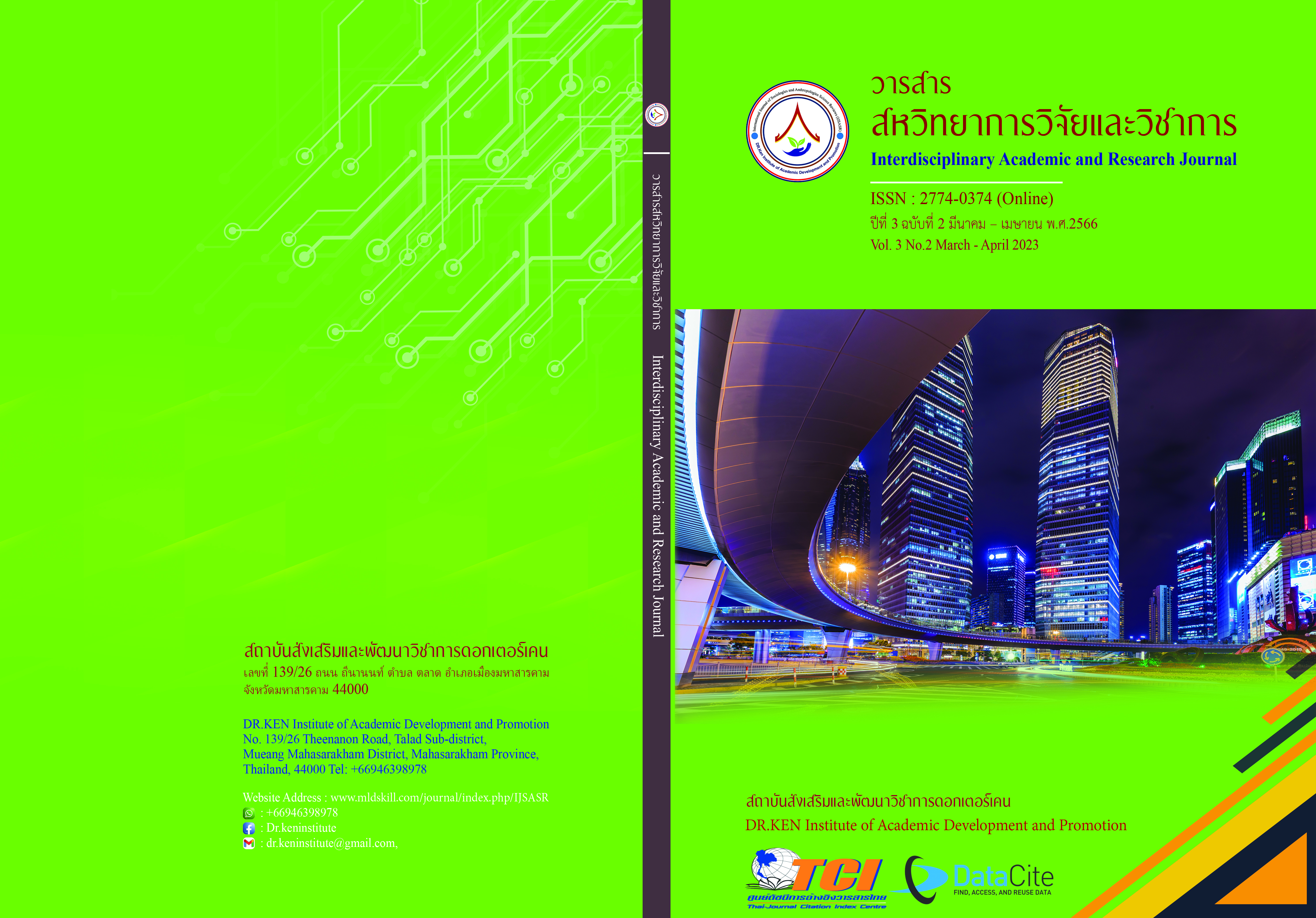Analyze the Behaviors of Using Online Teaching Media by Assure Model of Teachers’ Bunditpatanasilpa Institute
DOI:
https://doi.org/10.14456/iarj.2023.52Keywords:
Teacher's Teaching Behavior; , Online Teaching Media Used; , Assure ModelAbstract
Education management in the 21st century is an era that relies on the advancement of technology to accommodate changes that may occur all the time. In addition, the COVID-19 epidemic situation affects teaching and learning all over the world. Therefore, an adaptation of educational personnel is important to help learners learn effectively, even though the current situation of COVID-19 has eased, education in the new digital world still needs to be driven in line with the constantly evolving world population, able to study anytime, anywhere. Thus, this research article aims (1) To study the planning of instructional media usage with the Assure Model. (2) To analyze the behavior of using online teaching media with the Assure Model of teachers in Bunditpatanasilpa Institute. The sample group was 36 teachers which were chosen from a simple random sampling method. The data collection tool is an opinion questionnaire. The quantitative data analysis with basic statistics, and qualitative data using content analysis. The results showed that (1) using online teaching materials according to the 6-step Assure Model, the overall result was at the highest level. There was a statistical value of 4.54 and instructors in General Education and the Practical Education had no different behaviors in using online teaching materials. Moreover, the statistically significant was at 0.01 level consistent with the assumptions of the research. From the remarks on media planning using the Assure Model, the instructors focused on setting objectives, analyzing learner characteristics, and selecting, modifying, or designing online teaching materials at the highest level. (2) The opinions, problems, and obstacles in online teaching were the organization aspect, the teachers’ aspect, the students’ aspect, the material aspect, and the outbreak of the Coronavirus (COVID-19) 3. Suggestions for utilization 1) Instructors who use the Assure Model should have good skills in media creation and technology. 2) Teachers should study the use of various online media that meet the interests of the students and can be responded to learners' learning effectively. 3) Implement media planning with the Assure Model to teach both academic and practical subjects and 4) Administrators should have the policy to prepare teaching and learning equipment to be accessible, organize training, and should apply modern technology to the personnel.
References
กิดานันท์ มลิทอง. (2548). เทคโนโลยีและการสื่อสารเพื่อการศึกษา. กรุงเทพฯ : โรงพิมพ์อรุณพิมพ์.
กิตติพงษ์ พุ่มพวง. (2558). การพัฒนารูปแบบการเรียนการสอนอีเลิร์นนิงด้วยการเรียนรู้ร่วมกันผ่านสังคมออนไลน์เพื่อพัฒนาทักษะการรู้สารสนเทศ สำหรับผู้เรียนระดับปริญญาตรีคณะครุศาสตร์/ศึกษาศาสตร์. วิทยานิพนธ์นี้ปริญญาปรัชญาดุษฎีบัณฑิต. สาขาวิชาหลักสูตรและการสอน ภาควิชหลักสูตรและวิธีสอนบัณฑิตวิทยาลัย: มหาวิทยาลัยศิลปากร.
จันทวรรณ ปิยะวัฒน์. (2558). Flipping Your Class: ห้องเรียนกลับทาง. Retrieved on November 21, 2015 from www.eqd.cmu.ac.th/Innovation/media/2558/Jantawan.pdf
ถนอมพร (ตันพิพัฒน์) เลาหจรัสแสง. (2561). นวัตกรรมเทคโนโลยีสารสนเทศเพื่อการศึกษาในยุคการเรียนรู้ 4.0. เชียงใหม่ : ตองสาม ดีไซน์.
นิตยา มณีวงศ. (2564). “ศึกษาพฤติกรรมและปัจจัยความสำเร็จการเรียนออนไลน์แอปพลิเคชันไลน์ ในช่วงวิกฤต COVID 19”. Journal of Educational Studies.15 (1), 161-173.
บุญชม ศรีสะอาด. (2556). การวิจัยเบื้องต้น. พิมพ์ครั้งที่ 9. กรุงเทพฯ : สุวีริยาสาส์น.
ปณภา ภิรมย์นาค. (2555). รายงานวิจัยเพื่อพัฒนาการเรียนการสอนเรื่อง การใช้สื่อการสอนเชิงมัลติมีเดีย สาขาวิชาการจัดการโลจิสติกส์และโซ่อปทาน คณะบริหารธุรกิจ มหาวิทยาลัยศรีปทุม คณะบริหารธุรกิจ : มหาวิทยาลัยศรีปทุม.
พิไลวรรณ มาแป. (2560). ปัญหาและแนวทางการพัฒนาการใช้เทคโนโลยีสารสนเทศในการจัดการศึกษาของ ครูในโรงเรียนอำเภอสอยดาว สังกัดสำนักงานเขตพื้นที่การศึกษาประถมศึกษาจันทบุรีเขต 2. วิทยานิพนธ์ปริญญาการศึกษามหาบัณฑิต : มหาวิทยาลัยบูรพา
ยุทธนา กาเด็ม. (2564). แนวทางการปรับปรุงการเรียนการสอนที่สอดคล้องกับความต้องการของผู้เรียนแบบมีส่วนร่วม. Retrieved on 15 December 2022 from : http://www2.huso.tsu.ac.th/ncom/csd/csdful_pdf/f198.pdf
สุวรรณา จุ้ยทอง. (2565). ผลการจัดการเรียนรู้แบบผสมผสาน ในระบบออนไลน์ยุคปกติใหม่ โควิด-19 ที่มีต่อความสามารถในการเรียนรู้ของนักศึกษาครู. วารสารวิจัยรำไพพรรณี . 16 (2), 128.
Ally, M. (2006). Foundations of Educational Theory for Online Learning. In Terry Anderson. 15 December 2022 August 15, 2014: http://cde.athabascau.ca/online_book.
Heinich, R., Molenda, M., Russell, J.D & Smaldino, S.E. 1999. ASSURE MODEL. Retrieved 22 July 2013 from: http://ed205.net/assure_model.html
Whittaker, B. (1999). What Went Wrong Unsuccessful Information Technology Projects. Information Management & Computer Security, 7, 23-29.
Downloads
Published
How to Cite
Issue
Section
License
Copyright (c) 2023 ธนพัต ธรรมเจริญพงศ์

This work is licensed under a Creative Commons Attribution-NonCommercial-NoDerivatives 4.0 International License.
Copyright on any article in the Interdisciplinary Academic and Research Journal is retained by the author(s) under the under the Creative Commons Attribution-NonCommercial-NoDerivatives 4.0 International License. Permission to use text, content, images, etc. of publication. Any user to read, download, copy, distribute, print, search, or link to the full texts of articles, crawl them for indexing, pass them as data to software, or use them for any other lawful purpose. But do not use it for commercial use or with the intent to benefit any business.
















.png)


